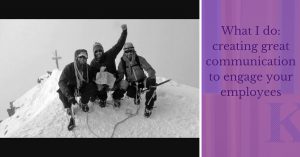How do you communicate? Do you thrive on a good conversation or speaking to a large group? Or do you prefer to get everything written down and handed out? Your communication style can have a huge impact on the way you engage and interact with your colleagues.
If you need to get others on board with overall strategy and good working practice, the way you get your message across is even more important.
Talking vs writing
Face to face communication is great if you do it well. Your audience can see your body language and hear your tone of voice. Equally, you can see whether they’re nodding and smiling or glazing over so you know immediately whether you’ve been understood.
The trouble with natural orators is that sometimes, everything is in their head. They prefer to just talk rather than looking at notes. This is great for engaging with your audience, but not so good if your enthusiasm for your subject leads you to concentrate on the bits you like and less on the more mundane details. Your big picture view on the project will determine the day to day reality for your employees so you need to deal with both.
If you prefer to write everything down, send out a newsletter and wait for people to respond, at least you know you’ve covered all the details. The trouble is, if you’re talking about big changes that will impact on your employees’ lives that approach isn’t going to work. They won’t hear you talk about positive changes and see the enthusiasm in your expression. They’ll be reading about an exciting new project but the overriding message will be that you didn’t want to face them in person because you were worried about their reaction.
Combining the two
So do you talk or write? Try both. Memory is highly selective and when you listen to someone speak you retain the bits that resonate with your view of the world. Having a conversation backed up by a written document means that you can gauge the reaction and answer questions but you have the benefit of knowing that there’s a backup in place if your audience immediately forget what you’ve told them when the meeting’s over.
How I can help
As regular readers will know, I used to be a solicitor. I’ve had years of experience in speaking to clients to find out about their business before reading documents, coming up with a strategy and writing a letter giving my advice. It means that I understand how important it is to be clear on all the little details. I can also be a sounding board for ideas and help you understand what might be important to your audience and how they’ll respond. I can also make sure that the written information you send out expresses your personality and that of your brand.
If you’re a natural talker, I can give you cues to make sure you include everything. If you’re not, I can give you the right kind of notes that you can glance at when you need to whilst retaining eye contact with your audience most of the time.
Best of all, I can then take all of the technical information and strategy and package it up into an easily digestible document. It’ll have all the important details but will be user friendly so your employees can refer to it quickly when they need to.
If you want to try a new approach to your employee communications or content marketing, get in touch at kirstyfrancewrites@outlook.com or register here to receive regular updates, special offers and a free copy of my guide, ’10 Tips to create copy that converts’.
Further reading
When to use face to face communication
How to tell when face to face communication is necessary – Business Insider
